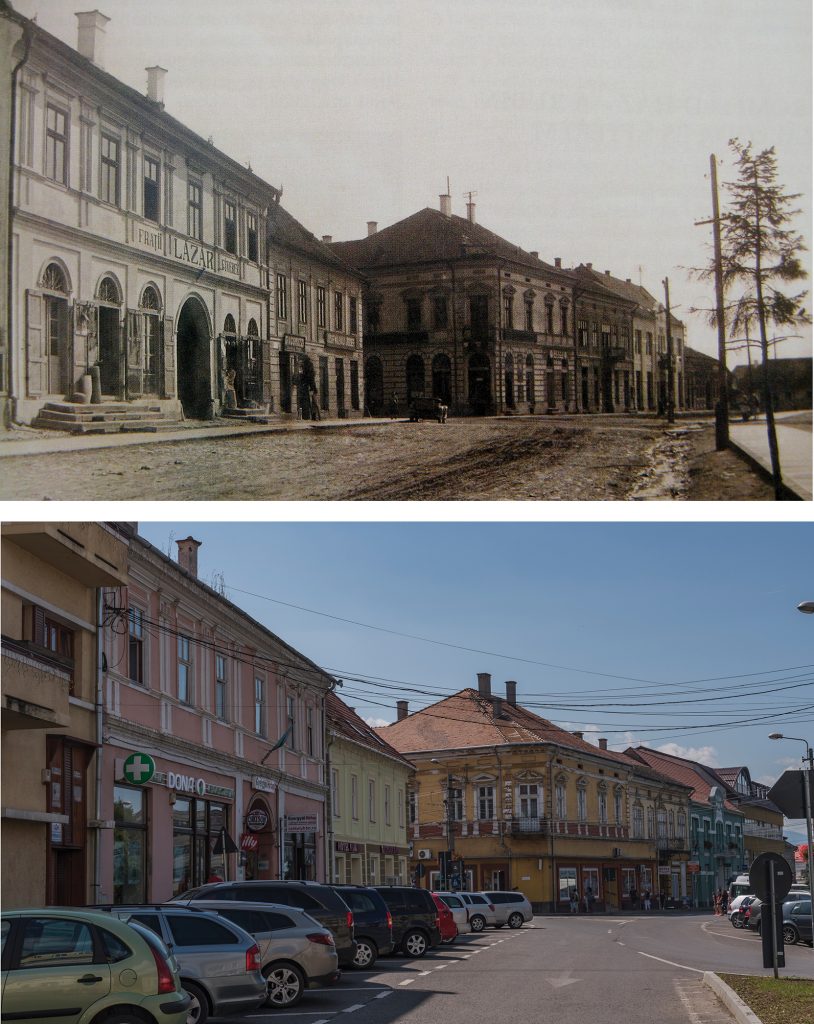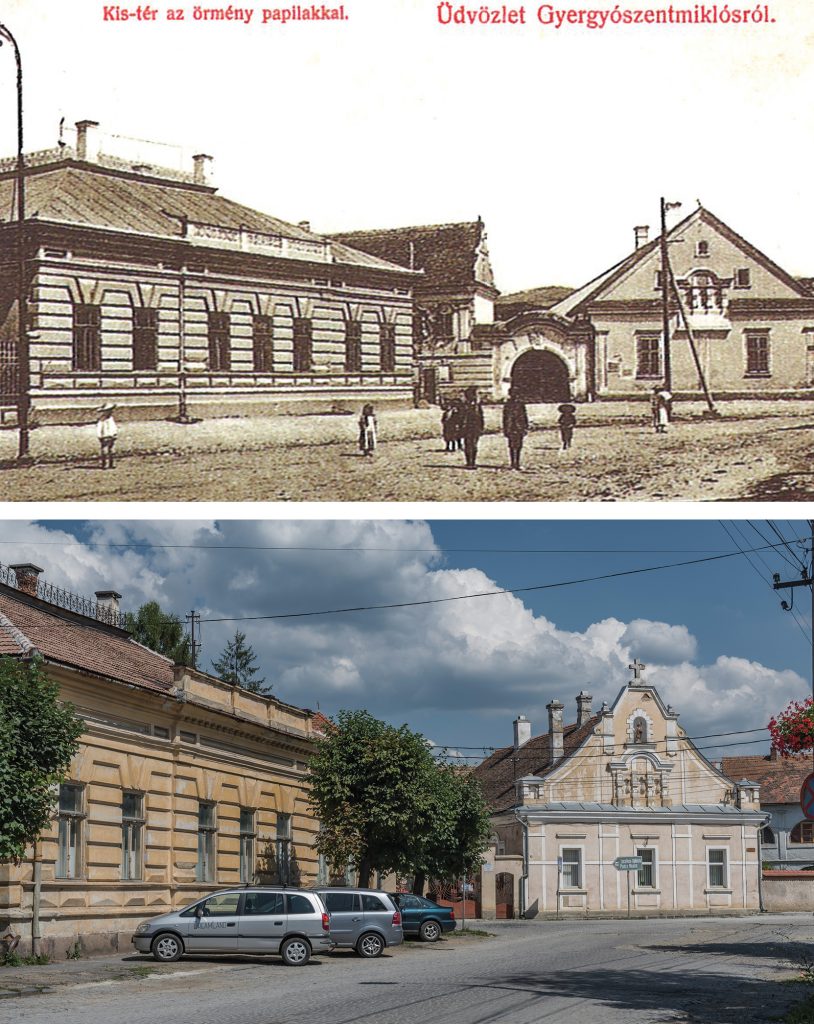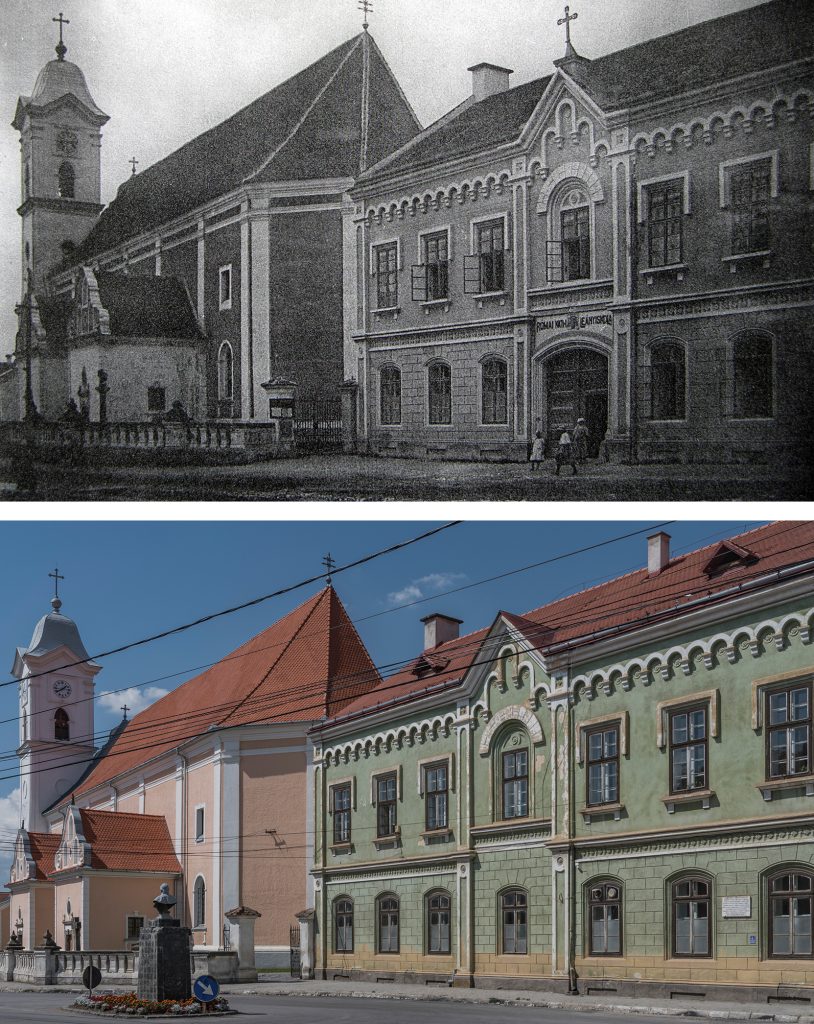For this second part of our project presenting past and present images of the same Transylvanian street scenes, we continue with three pairs of photos of the town of Gyergyószentmiklós (Niklasmarkt, Gheorheni). In our first part, we outlined some of the most essential processes in the history of development and urbanization of this town, including the establishment of Armenian families in the seventeenth and eighteenth centuries and the earning of the right to organize market fairs in 1607.
The first pair of photos show a view of the street named after a famous cannon foundry master of the nineteenth century, Áron Gábor. The house at number 2 (the grandiose orange-colored corner building) belonged to the Vákár family and was built in 1901 in an eclectic style. The Vákár Brothers’ company was founded on October 11, 1874, and, according to their trade license, they ran a department store, with one sign advertising the Vákár Brothers’s SPICE DELICACY VINE WHOLESALE. Their flagship business was based on reliability, accuracy, and cleanliness, and their high-quality vines were brought in from the era’s vineyards, for example, from around Szászrégen (Sächsisch-Regen, Reghin) and Baranya County of Hungary. Their thriving business ended with the nationalization of 1948. Between 1921 and 1933, this house was also home to József Málnásy Clothing for Men and Women.

A descendant of the Vákárs, Mária Lázár recounted in an interview that the family who had built the house was quite large, with ten children. They originally lived in the village of Gyergyószárhegy (Grünberg, Lăzarea) and had won a larger amount of money from bonds that were bought for their youngest child. The head of the family, László Vákár, the great-grandfather of Mária Lázár, was a merchant, but they also had a farm. “When the lady of the house went to church with her daughters, they used two carriages. She sat in one with her two brown-haired daughters, whilst her three red-haired girls sat in the other one,” Mária Lázár recounted. László Vákár was also an amateur photographer. From one of home’s upper-story windows, he took several photos of the crowds that gathered for the fairs. He developed his photos in his own laboratory, and he contributed greatly to the documentary images of the town and its surroundings during his time.
In the second pair of photos, one can see the Armenian parish located at No. 2 Armenian Church Street. This place was once named the Small Square and was the location of the town’s marketplace in the seventeenth century. The vicarage had bought the first lot of the parish in 1768 from a foot soldier for 100 forint. They then enlarged it with another parcel bought from the widow of the same soldier. According to the Armenian Catholic Historia Domus (the history of the church), the parish was built in 1769 and the chaplain’s house in 1780. These buildings were to be used by two priests. In 1874 the chaplain’s house was destroyed in a huge fire, but the Armenian community soon gathered donations and rebuilt it. Later in 1894, they decided to renovate the buildings, and the parish received a new stone gate, a new basement door, and a fully renovated façade.

In 1912, the parish and the chaplain’s house were again restored by the Holy Trinity Society of the Fellows. The smaller house of the choirmaster and bell ringers was also built on the lot. Before the 1874 fire, a roofed corridor connected the graveyard of the church and the parish, which was useful on rainy, muddy days. But this was unfortunately engulfed by the flames, and there exists no illustration of it either.
The third lot shows Saint Nicholas Church standing in the city center, which is actually the oldest house of God in the town. The first Catholic Church at this location was built in the fifteenth century in Gothic style. In the second half of the seventeenth century, a new, bigger church replaced the medieval one. As its name suggests, its patron is Saint Nicholas, and a procession has been held on his day since 1990.

Title image: Detail of the Armenian Art Festival of Gyergyószentmiklós. Photo: Gyergyószentmiklós / Facebook